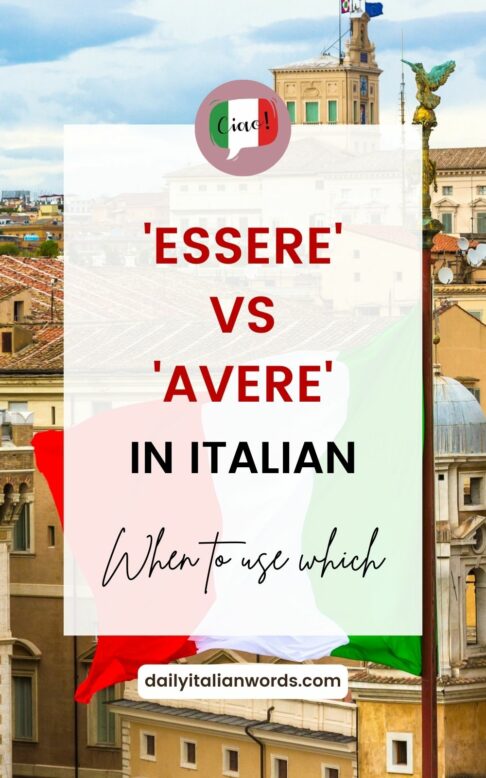Luckily for learners, Italian and English are two languages close enough to have a rather similar use of the verbs essere (to be) and avere (to have).
In most cases, an intuitive use of these two verbs may be correct, but if you wish to improve your knowledge of Italian, it is necessary to point out some important differences.
In order to address this topic in a clear way, I will divide this explanation into six parts and a few shorter paragraphs.

PART 1. Differences in the Use of ‘Essere’ and ‘Avere’ in Everyday Sentences
1.1 When you introduce yourself in Italian, you can use the verb essere to say your name, profession, and nationality:
- Sono Roberto = I am Roberto
- Sono insegnante di matematica = I am a math teacher
- Sono svizzero = I’m Swiss
But when it comes to communicating your age (if you really have to) remember to use avere:
- Ho 45 anni = I’m 45 years old
This literally corresponds to the English: I have 45 years.
Later on, it might be appropriate to ask ‘How are you?’ which in Italian is perceived as a real question and not only as a form of greeting. In this case, remember to translate the verb to be with stare (to stay):
- Come stai? = How are you?
- Sto bene, grazie = I’m fine, thanks
1.2 You can of course express your emotions and feelings with the verb essere:
- Sono felice = I am happy
- Sono triste = I am sad
However, there is a different way of expressing some important physical needs, which call for the verb avere:
- Ho fame = I’m hungry
- Ho sete = I’m thirsty
- Ho sonno = I’m sleepy
1.3 When something is not really clear or doesn’t seem like the right thing to do, you can say:
- Non ha senso! = It doesn’t make sense!
In this case you can’t translate make with fare. Which is funny because very often the opposite is true, as in fare la doccia (to have a shower), fare colazione (to have breakfast), fare una passeggiata (to have a walk), and so on.
1.4 Avere voglia di This is a commonly used formula to express the desire to do or experience something. The intensity of this desire depends on the context in which it is expressed.
- Ho voglia di fare una passeggiata = I feel like (going for) a walk
- Non ho voglia di lavorare oggi = I don’t feel like working today
- Hai voglia di un gelato? = Do you want/fancy an ice cream?
PART 2. ‘Avercela’ and ‘Esserci’
Avercela and esserci are two ‘verbi pronominali’. A verb is called ‘pronominale’ when one or more pronouns are added to its original form, changing its meaning.
In this case:
- Avere + ci + la = avercela
- Essere + ci = esserci
New meanings:
- Avercela (con qualcuno) = to be upset/mad (with/at someone)
- Esserci = to be there
Examples:
- Marco ce l’ha con Paolo perché non l’ha invitato alla festa = Marco is mad at Paolo because he didn’t invite him to the party
- Non so se c’è ancora del latte in frigo = I don’t know if there’s any more milk in the fridge
PART 3. ‘Essere’ and ‘Avere’ in Compound Tenses
3.1 A compound tense is a verb construction that uses more than one word to express a meaning, while a simple tense just needs one. This happens both in Italian and English, but with an important difference. In English the auxiliary verb – the first word of a compound tense – is always a form of the verb ‘to have‘, while in Italian it can be a form of avere or essere.
There is actually something more to say about compound tenses in their progressive form, but we will see that in the next paragraph.
Examples of Simple Tenses are the presente indicativo in Italian and the present simple in English:
- Elisa legge = Elisa reads
- Noi camminiamo = We walk
Examples of Compound Tenses are the passato prossimo and the present perfect :
- Elisa ha letto = Elisa has read
- Noi abbiamo camminato = We have walked
Due to the similarity between these tenses in the two languages, the following examples in this paragraph will be in the passato prossimo accompanied by a preferred translation in the present perfect. In real life, though, the past simple tense may be the most suitable option.
So how do we know which auxiliary verb to use in Italian? Here is a possible method: we assume that avere (to have) is the default auxiliary verb but that we need to change it to essere (to be) in some special circumstances.
We have to use the verb essere in the following cases:
Compound tenses of the verb essere itself:
- Io sono stato = I have been
- Noi siamo stati = We have been
Compound tenses of verbs that describe a change or transformation:
- Crescere → io sono cresciuto = I have grown
- Diventare → io sono diventato = I have become
- Cambiare → io sono cambiato = I have changed
- Dimagrire → io sono dimagrito = I have lost weight
- Ingrassare → io sono ingrassato = I have put on weight
Compound tenses of verbs that indicate a “directional” movement, but do not describe how the movement happens:
We use essere with:
- Andare → io sono andato = I have gone
- Uscire → io sono uscito = I have gone out/exited
- Arrivare → io sono arrivato = I have arrived
- Tornare → io sono tornato = I have come back
But we use avere with:
- Camminare → io ho camminato = I have walked
- Ballare → io ho ballato = I have danced
- Correre → io ho corso = I have run
Compound tenses that indicate your location:
- Stare → io sono stato = I have stayed
- Rimanere → io sono rimasto = I have remained
Compound tenses of reflexive verbs:
- Svegliarsi → io mi sono svegliato = I have woken up
- Ricordarsi → io mi sono ricordato = I have remembered
- Presentarsi → io mi sono presentato = I have introduced myself
3.2 Progressive tenses are a specific type of compound tenses that describe ongoing actions in the past, present, and future. It sounds complicated but just take a look at the following English / Italian examples and try to notice what happens in the translation:
Past: I was eating = io stavo mangiando
Present: I am eating = io sto mangiando
Future: I’ll be eating = io starò mangiando
Well, besides the fact that the English suffix -ing becomes -ando in Italian (and in other cases -endo), the most remarkable thing is that to be here is not translated with essere, but with stare / to stay.
This happened before, do you remember when? In case you don’t, you should read this article one more time!
PART 4. ‘Essere’ and ‘Avere’ as Auxiliary of Modal Verbs
Modal verbs are particular verbs that can have an autonomous meaning or be linked to another verb to ‘modulate’ its meaning. When they are autonomous, volere (to want), dovere (must / to have to), potere (can / to be able) and sometimes sapere (to know / to know how) always have avere as their auxiliary verb:
- Marco ha voluto il gelato e non la torta = Marco wanted the ice cream, not the cake
But when they refer to other verbs it is better to use the auxiliary of the verb whose meaning they modulate. In the following examples, you can see that two different auxiliaries are used because of the verbs that follow dovere.
- Sono dovuto andare in ufficio prima = I had to go to the office earlier
- Hanno dovuto prendere una decisione = They had to make a decision
PART 5. Impersonal Forms
Impersonal forms are used to express general actions and can be constructed in different ways. Most of the time, they need essere with the exception of verbs used to talk about the weather (see paragraph 5.4.)
5.1 Essere + adjective / adverb:
- È possibile riprogrammare la lezione? = Is it possible to reschedule the lesson?
- È necessario scaricare l’app = It is necessary to download the app
- È bene ripeterlo = It is good to repeat it
5.2 Verbs that form what is called ‘proposizione soggettiva’ in Italian:
- È successo molti anni fa = It happened many years ago
- È sembrato inusuale a tutti = It seemed unusual to everyone
- È consigliato mangiare verdure = It is recommended to eat vegetables
5.3 The frequent impersonal construction ‘si+verb’ also requires the auxiliary essere in compound tenses:
- Si mangia → Sì è mangiato
- Si visita Siena → Si è visitato Siena
- Si dicono tante cose → Si sono dette tante cose
5.4 When you want to use weather verbs, although you can use essere as an auxiliary verb most of the time, it is preferable to switch to avere when you want to emphasise the duration of the action.
- È piovuto un po’ stamattina = It rained a little this morning
- Ieri ha piovuto per due ore = Yesterday it rained for two hours
PART 6. Passive Forms
In Italian the passive form is never built on the verb avere, but on the verb essere, and in some cases also on the verb venire (only if venire is employed as a simple tense):
- La carota è / viene mangiata dal coniglio = The carrot is eaten by the rabbit
- La riunione è stata rinviata = The meeting has been postponed
Do you feel a little more comfortable with the differences between avere and essere in Italian? Let us know in the comments below!

Written by Nicco Curini, certified teacher of Italian since 2016, working online since 2019. Website: ditelab.blogspot.com | Social media: Instagram – Facebook – Twitter

Niccolò Curini has been teaching Italian since February 2016, primarily at the Language Center of the University of Goettingen in Germany. In this role, he led courses ranging from level A1 to B2. To qualify for this position, he obtained the DITALS certification, enabling him to teach Italian as a Foreign Language to university students. Social media: Instagram – Facebook – Twitter


